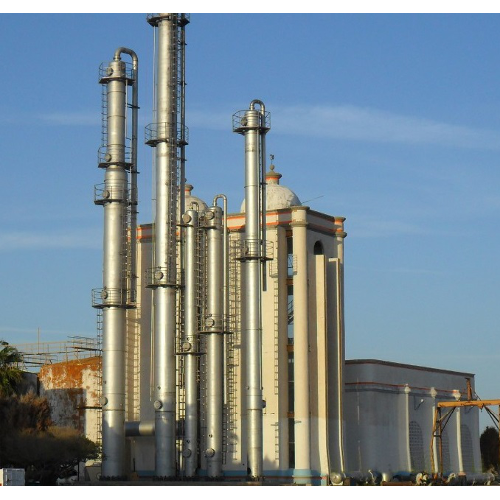Ethyl Acetate Manufacturing Plants
Ethyl Acetate Plants are designed mixing acetic acid and ethyl alcohol in a balanced proportion through a preheater to a kettle reboiler for distillation purpose. These plants are used in various cosmetic, chemical and pharmaceuticals industries for processing and storage of various products. Further, these plants and machines are designed and developed in different technical specifications, which fit the diverse requirements of the clients. Ethyl Acetate is an organic chemical which has a pleasant fragrance and is colorless and low toxic in nature. Processed in these plants using top quality ingredients, our offered products are highly miscible with diethyl ether, acetone, ethanol & benzene and are widely used in nail polish remover & glues.
We have gained immense appreciation among our clients for our manufactured and supplied assortment of Ethyl Acetate Plants. In this plant, acetic acid and ethyl alcohol is mixed in a balanced proportion through a preheater to a kettle reboiler for distillation purpose. This plant is known for its robust construction and ability continuously running at even high speeds.
Applications:
Features:
Description:
Ethyl acetate is a product of esterification reaction between ethyl alcohol and acetic acid.
The reaction can be represented by CH2CH2OH + CH3COOH—- > CH3COOC2H5 + H2O
Acetic acid and ethyl alcohol are sent in a fixed proportion through a preheater to a kettle reboiler. Small amount of catalyst is added into the kettle. The reaction products are carried to the top of the column as an azeotrope, condensed and pass to a decanter. The top over flow from the decanter is partly given as reflux.The remaining part of the top over flow along with bottom of the decanter is sent to a mixer. The mixer also receives top product of the recovery column and also partly the top product of E.A.Column. The contents of the mixer after thorough stirring are sent to a settler. Top over flow from the settler is sent to E.A. Column. The product E.A. is drawn from the bottom. The top product of the E.A. Column is sent partly to mixer as stated above. Bottom flow of the settler is sent to recovery column whose bottoms are sent to drain. The top product after meeting reflux requirements is sent to mixer
REACTIVE DISTILLATION:
Ethyl acetate is normally produced by esterification of ethanol and acetic acid. A reactive distillation column, combining the reaction and separation into a single stage, is proposed.Reactive distillation represents an integration of a chemical reaction and distillation in a single multifunctional process unit. Chemical equilibrium limitations can be overcome, higher selectivity can be achieved, and the heat of reaction can be used in situ for distillation. These are the basic advantages of the integration considered.
Ethyl acetate is one of the most widely used fatty acid ester and is a quick-drying solvent with excellent solubility. As an excellent industrial solvent it finds an application as an important component of extractants used for antibiotics concentration and purification and an intermediate in the manufacture of various drugs. This solvent is applied in the manufacture of adhesives, cleaning fluids, nail-polish removers and Metallurgy coated papers, explosives, artificial leather, photographic films and plates.Other applications of ethyl acetate are associated with the manufacture of synthetic fruit essences, flavors and perfumes. It can be used as the standard material and solvent for analytical reagents and chromatography analysis.
Ethyl acetate is produced through esterification of ethyl alcohol and acetic acid. This process is described as an acid catalyzed equilibrium synthesis developed by Emil Fischer. The mechanism proposed for esterification involving an alcohol and carboxylic acid is an acid promoted acyl substitution, which results in the substitution of an alkoxy group for the hydroxyl portion of the carboxyl group.
The water formed in the course of the reaction (and also from the 90 % alcohol used as a raw material) is continuously removed. The conditions chosen provide the maximum conversion of acetic acid, which is costlier than ethyl alcohol.

